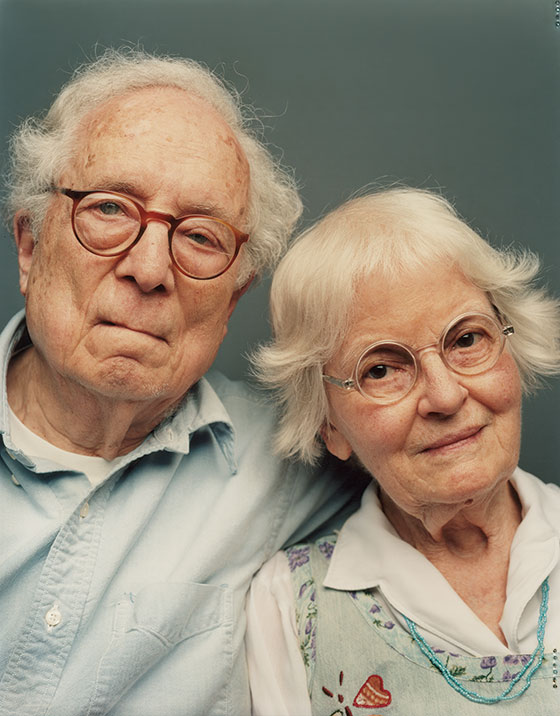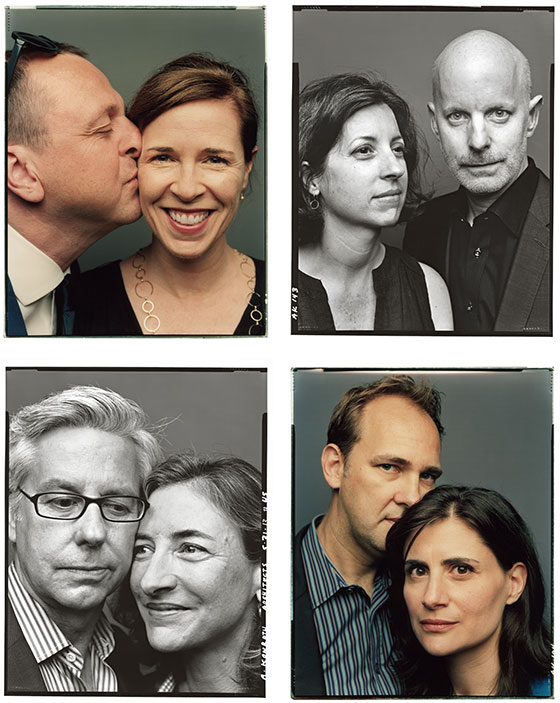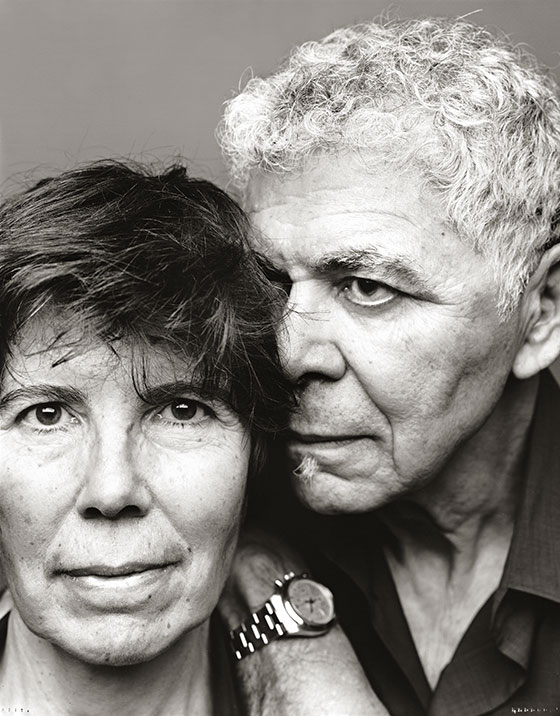
Architecture is an art that thrives on argument. The silent battles that poets and sculptors wage with themselves, architects need to articulate. Because a skyscraper costs so much more than a sonnet, because in the end others will build it, and because the finished product won’t stand isolated on a page or a pedestal, people who design buildings expend their creative energies suggesting, defending, criticizing, revising, and adjusting to a thousand external needs. And since you can argue creatively only with someone you trust, what better sparring partner than a spouse?
Jing Liu, who in 2008 founded the firm SO-IL with her husband, Florian Idenburg, says that creative tension winds its way through their private lives. “We can afford to fight it out over days and days. You don’t chicken out of the argument. You just keep going at it until you have a resolution.” And husband-and-wife firms are not just proliferating; they’re dominating. Several ubiquitous New York firms—SHoP Architects, Diller Scofidio + Renfro, Asymptote Architecture, and Tod Williams Billie Tsien—were founded by couples. The next generation of boutique studios, too, is thick with them, including Idenburg and Liu, and Amale Andraos and Dan Wood, the principals of WORKac. The phenomenon is hardly new, but it still cuts against two enduring fallacies: that men build as women help, and that the noblest kind of architect is a Napoleon of the blueprint, dispatching orders for others to carry out.
The architect Denise Scott Brown is best known for Learning From Las Vegas, the irreverent, revolutionary book from 1972 about the glories of trashy American buildings and their hyperbolic signs that she wrote with her husband and partner, Robert Venturi. Lately, she is second-best-known for not winning the prestigious Pritzker Prize in 1991, when Venturi did. They met in 1960, married in ’67, and two years later went into business as Venturi, Scott Brown and Associates. For decades, they cooperated, co-designed, and frequently co-wrote; few outsiders can pin down which of them did what. In April, prompted by a wish for belated recognition that Scott Brown expressed in an interview with Architects’ Journal, a group of students at the Harvard Graduate School of Design posted an online petition to correct that injustice. So far, more than 16,000 people have signed it, including many of the profession’s heavyweights and nine Pritzker laureates (including Venturi himself). The group that administers the prize promised to pass the buck to the next jury, which has also punted.
The petition is partly an effort to combat the field’s chronic misogyny. In a recent interview in Architect magazine, Brown described decades of pinprick humiliations: clients who ignored her and talked only to Venturi, get-togethers at all-male clubs, a request to step away from a group of architects that was posing for a photograph, accusations that she was resentful, shrewish, and demanding. Today a less-candid sexism comes out in the numbers: Women make up about half of all architecture students but only 17 percent of practicing architects. Zaha Hadid remains the only woman to win the Pritzker on her own. And although Kazuyo Sejima, the female co-founder of Sanaa, did win along with her younger (male) partner Ryue Nishizawa in 2010, the next year’s prize once again went to the male half of a two-person partnership: the Chinese architect Wang Shu, but not his wife, Lu Wenyu. (Women are reaping other laurels, though: the first $100,000 Wheelwright Prize has just been awarded to the 35-year-old Brooklyn architect Gia Wolff.)
But the Scott Brown controversy also shows how hard it is to dismantle the myth of the solitary auteur popularized by Ayn Rand in The Fountainhead. “A building is alive, like a man,” declaims the young architectural genius Howard Roark. “Its maker gives it the soul and every wall, window and stairway to express it.” Roark’s first nemesis is the cringing dean of his architecture school, who responds with a paean to compromise: “Nothing has ever been invented by one man in architecture. The proper creative process is a slow, gradual, anonymous, collective one,” he whines. In Rand’s world, he might as well be chairing the committee that tried to design a horse and came up with a camel.

Back in the real world, the married-partner model has proved powerful, not because it fosters a homey atmosphere of concord and compromise but because it allows two loyal but opinionated people, with compatible levels of obsessiveness and drive, to feed off each other’s energies. Couples who design together barely acknowledge any distinction between work and family. Children nap in the model shop. Dinner is spent discussing the minutiae of alloy cladding. Having a spouse as a colleague relieves workaholics from having to make apologetic calls about being late for dinner—or anything else. “Being in a marriage diminishes the need to explain,” says Marion Weiss, the female half of the firm Weiss/Manfredi. Husbands not only know what their wives are doing but exactly how long they’ve been working on those damn handrails. Married architects sometimes sound as if they inhabit a parody of a type-A romance. “The gift is that you get to work all the time, as much as you want, and it floats in and out of our relationship,” says Elizabeth Ranieri, who co-founded the San Francisco firm Kuth/Ranieri Architects with her husband in 1990.
It takes a sturdy relationship to withstand the pressures of working together, and architecture can be especially punishing, especially as deadlines approach. Some spouses make joint appearances at client meetings and public presentations, so that they travel in tandem and are together virtually all the time. Others, like Idenburg and Liu, divide up the labor and thus hardly see each other. “We’d love to travel together, but it’s not realistic,” Idenburg says. “Last fall it was a relay race: We’d have a cab bringing one of us from the airport and the other back out to the airport, with the kids waiting in the vestibule for the handoff.”
Architect spouses must figure out both how to collaborate seamlessly and how to fight creatively—without tearing at each other or harming the product. Working on their first joint project, Weiss and her husband, Michael Manfredi, discovered that they were both left-handed and that their drawing styles meshed so seamlessly that they could be sitting in different countries, working on different views, and the result would be totally unified. “We’ll literally draw all over each other’s stuff,” Manfredi says. “There are drawings where I don’t know which is my mark and which is Marion’s.”
The terms draw and mark may be unfamiliar to younger architects who work almost exclusively on computers, and in fact technology has helped erode the one-man-one-brainwave approach. Networked software makes it easy for many people to work on the same design simultaneously. Complex projects involve such a tangle of disciplines that they begin not with a sketch but with a meeting. Even Howard Roark would have to call in HVAC companies, acoustical consultants, I.T. specialists, and land-use lawyers. Couples, already accustomed to collaborating, can also pool their expertise, which may be why Weiss/Manfredi and WORKac both have the rare ability to merge architecture and landscape.
Synchronicity has its limits, though. In the depths of the design process, if one partner gets discouraged, the other has to cajole. Sometimes teamwork requires being able to toggle among independence, conflict, and consensus. “If we’ve got two options and neither of them works, sometimes we’ll go into different rooms and take a crack at solutions three or four,” says Weiss. “Then we’ll get back together to find that all of them have failed. But something new emerges.” Several couples say that finding common ground can mean not compromising between conflicting visions but jettisoning both to produce fresh alternatives.

While inspiration can provide a basic form or an ingenious solution, most of the work of architecture involves churning out and discarding options by the dozen. Busy studios are papered with sketches thumbtacked to the walls and cluttered with foam-and-paper models tracing the fitful evolution of a final design. Perfectionism reigns, so being able to inflict criticism, and take it, are essential tools of the trade. “Ninety percent of problems get resolved very fast,” says Amale Andraos of WORKac. “But 10 percent of the time there’s violent disagreement, and that’s where the interesting stuff happens. Over the years we’ve come to realize that if one of us disagrees, that means it’s not good enough.” Andraos’s husband, Dan Wood, finishes the thought: “There’s a short period where you try to defend your side.”
Those arguments can be awkward for their employees, who are captive witnesses, like children in a fractious marriage. “A lot of the fireworks come out in front of everyone,” admits Andraos, whose office employs about 40 people. “I’m sure it’s uncomfortable for the staff, because it can sound personal even when it’s not. The advantage of being a couple is that you’re not wearing any gloves. There’s no fear of hurting the other’s feelings. It’s almost as if you were arguing with yourself.” It’s not that feelings don’t get hurt; it’s that, as in boxing, bruises come with the territory. “We’re both very thin-skinned and hypersensitive,” says Marion Weiss, “so we’re constantly feeling tender. But we’re after something beyond our own egos.”
